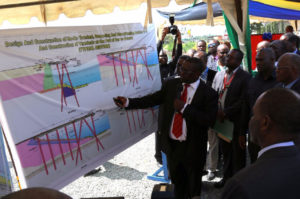by Ben Taylor
Dar port expansion underway
In July, President John Magufuli laid the foundation stone to launch construction works at Dar es Salaam port to deepen and upgrade seven of the port’s berths.
Dr Magufuli was informed that at present, only ships up to 243m in length and with carrying capacity of between 2,500 and 4,000 twenty-foot equivalent units (TEUs) can dock, but that following the upgrading works, the port will accommodate Post Panamax ships with 320-metre lengths and carrying capacity of up to 8,000 TEUs.
The Dar es Salaam Maritime Gateway Project (DMGP) is supported by the World Bank, which has offered a USD $345m loan, and the United Kingdom through the Department for International Development (DfID) through a USD $12.4m grant. The Tanzanian government, through own sources, will provide USD $63.4m.
The upgrading of the country’s major port is expected to enable more ships to dock, offload and load shipments at the harbour at the same time, reducing dwell time and enhancing efficiency. Dwell time at the port is expected to drop from 80 to 30 hours.
President Magufuli was impressed by the project and instructed the contractor, China Harbour Engineering Company (CHEC), to fast-track the project from 36 to between 28 and 30 months.
“This project will benefit not only Tanzania but her landlocked neighbours like Rwanda, Zambia, Burundi, Uganda, Malawi and Democratic Republic of Congo (DRC). The envisaged Standard Gauge Railway (SGR) will highly depend on the effectiveness of the port that handles 90 per cent of imported goods,” he said.
The entrance channel will have its depth deepened from 10.2m to 15.5m for a distance of 8km and its width widened from 140m to 170m, explained the Director General of Tanzania Ports Authority (TPA), Eng Deusdedit Kakoko. (Daily News)
Dar es Salaam wins Sustainable Transport Award
Dar es Salaam was announced the winner of the Sustainable Transport Award by the Institute for Transport Development and Policy (ITDP) in New York. This makes Dar the first African city to win the prestigious award.
ITDP notes that Dar had “launched a series of transformative improvements to transit, cycling and walking” in the past year, the most important of which is the Dar es Salaam Bus Rapid Transit (BRT) system, or DART. “DART is a high-quality, high-capacity BRT system incorporating best practice design and features, is the first true BRT system in East Africa. It spans 21 km of trunk route, and serves 160,000 passengers per day on average with the current fleet of 140 buses. By mid-2018, when the first phase becomes fully operational with over 300 buses, the system is projected to carry an estimated 400,000 passengers per day. DART has reduced commute times by more than half for residents.”
“Serving the key axis of Morogoro Road and running through the city centre, DART is more than a public transit system, it has brought improvements for pedestrians and cyclists as well. The project includes cycle paths, sidewalks, and improved pedestrian safety with well-designed, at-grade pedestrian crossings also complying with universal accessibility principles.” (The Guardian)
Eleven locomotives abandoned
The government has ordered Tanzania Railway Limited (TRL) and Tanzania Ports Authority (TPA) to explain the circumstances that led to the abandoning of eleven locomotives at the Dar es Salaam port.
The deputy minister of Works, Transport and Communications, Edwin Ngonyani ordered a report in July, a day after President John Magufuli had hinted at “dirty games” in the procurement process of the locomotives that arrived at the port a week earlier.
TPA director general Mr Deusdedit Kakoko told reporters that the locomotives belonged to TRL. It seems, however, that TRL had a dispute with the suppliers of the locomotives that TPA was not aware of at the time of clearing the consignment, according to Mr Kakoko.
The Citizen newspaper reported that the locomotives were dispatched in fulfilment of the contract signed in 2013 between TRL and a US based firm, Electro-Motive Diesel (EMD). A statement issued by the then TRL director general, Mr Kipallo Kisamfu said TSh70.9 billion had been paid to the contractor on 13 locomotives which would be dispatched in three phases. (The Citizen)
St Lucky Vincent school bus tragedy
Thirty-five people died when a bus carrying pupils from St Lucky Vincent School in Arusha crashed into a gorge in Karatu District in May. Among the dead were two teachers and a driver, and thirty-two pupils. They were travelling to Karatu to take part in mock examinations.
Vice President Samia Suluhu led mourners at a communal mass. Three survivors were taken to the US for treatment, and have made good progress. They are expected to return to Tanzanian sometime in August. (Daily News, The Citizen, The Guardian)

